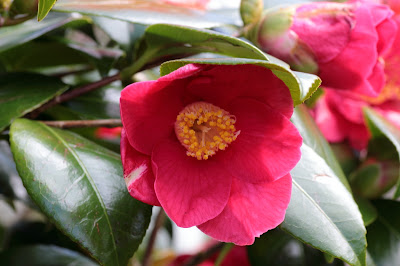A couple of warm, sunny days recently gave me the chance to travel across the Tamar to visit the National Camellia collection housed in
Mount Edgcumbe Country Park. Housed in the woodland which sits above the formal gardens and the house, the collection benefits from the mild winter climate on the edge of Plymouth Sound and has grown over the years to comprise more than 1000 species and varieties. Some are recent additions but there are some older specimens showing the full potential of these lovely plants.
A single visit is only a snapshot, of course. Autumn flowering Camellia sasanqua varieties are not in flower and some of the earlier flowering varieties were going over despite the late start to spring this year. But even so, I could only photograph a fraction of the collection in the time available. But that's enough to give a glimpse of the sheer diversity this genus offers. And all at a time of year when masses of colour is welcome after the winter.
Camellia japonica types and cultivars are very well represented. Here's a sample, running the gamut from plain single flowers, through more formal semi-doubles and doubles to the blowsier paeony forms. Click the pictures to embiggen:
 |
| Camellia japonica 'Finlandia' |
 |
| Camellia japonica 'Grand Slam' |
 |
| Camellia japonica 'Laura Schafer' |
 |
| Camellia japonica 'Rubescens Major' |
 |
| Camellia japonica 'Chandlerii' |
 |
| Camellia japonica 'Dainty Dale' |
 |
| Camellia japonica 'Duchesse Decazes' |
 |
| Camellia japonica 'Erin Farmer' |
 |
| Camellia japonica 'Jingle Bells' |
 |
| Camellia japonica 'Jupiter' |
 |
| Camellia japonica 'Lady de Saumarez' |
 |
| Camellia japonica 'Ludgvan Red' |
 |
| Camellia japonica 'Maculata Superba' |
 |
| Camellia japonica 'Mrs Anne Marie Hovey' |
 |
| Camellia japonica 'Nuccio's Pearl' |
 |
| Camellia japonica 'Lady Vansittart Blush' |
 |
| Camellia japonica 'Lady Vansittart Blush' again - no two flowers are alike |
 |
| Camellia japonica 'Onetia Holland' |
 |
| Camellia japonica 'Spencer's Pink' |
 |
| Camellia japonica 'The Czar' |
 |
| Camellia japonica 'Tinker Bell' |
 |
| Camellia japonica 'Valteverada' |
If the
C.japonica types have a problem it's that the flowers are vulnerable to spring frosts and even though replaced with newly opened buds are not promptly shed. In bad years they can become unsightly. The late flowering this year has coincided with warmer weather without night frosts and so many flowers were almost perfect (though the whites and pale pinks can still show a little browning on the edge petals.
The
Camellia x williamsii crosses are often even larger and more prolific in flower - and easily shed old, spent flowers. For most of us they represent better garden value. Needless to say there is no shortage in the collection:
 |
| Camellia x williamsii 'Les Jury' |
 |
| Camellia x williamsii 'Marjorie Williams' |
 |
| Camellia x williamsii 'Debbie Carnation' |
 |
| Camellia x williamsii 'Inspiration' |
 |
| Camellia x williamsii 'Rosemary Sawle' |
 |
| Camellia x williamsii 'Tristrem Carlyon' |
Most flamboyant of all are the
Camellia reticulata varieties and hybrids. With big, blowsy flowers, oversized leaves and attractive small tree habits they are, unfortunately, not as hardy as
C.japonica or
C x williamsii but do well here in the warmer wintered South West. A section of the woodland is given over to these camellias and they do look impressive in flower.
 |
| Panorama shot of part of the Camellia reticulata collection - click to embiggen |
Individual flowers can be 8in / 20cm across with some of these - but they all look good. Now, where can I clear some space in my little plot?
 |
| Camellia reticulata 'Dream Castle' |
 |
| Camellia reticulata 'Ming Temple' |
 |
| Camellia reticulata 'Royalty' |
 |
| Camellia saluenensis x reticulata 'Valentine Day' |
 |
| Camellia reticulata x japonica 'Lasca Beauty' |
All in all a very pleasant afternoon spent amongst these beautiful spring flowering shrubs.



































One of the joys of spring, seeing camellias in full bloom!
ReplyDelete